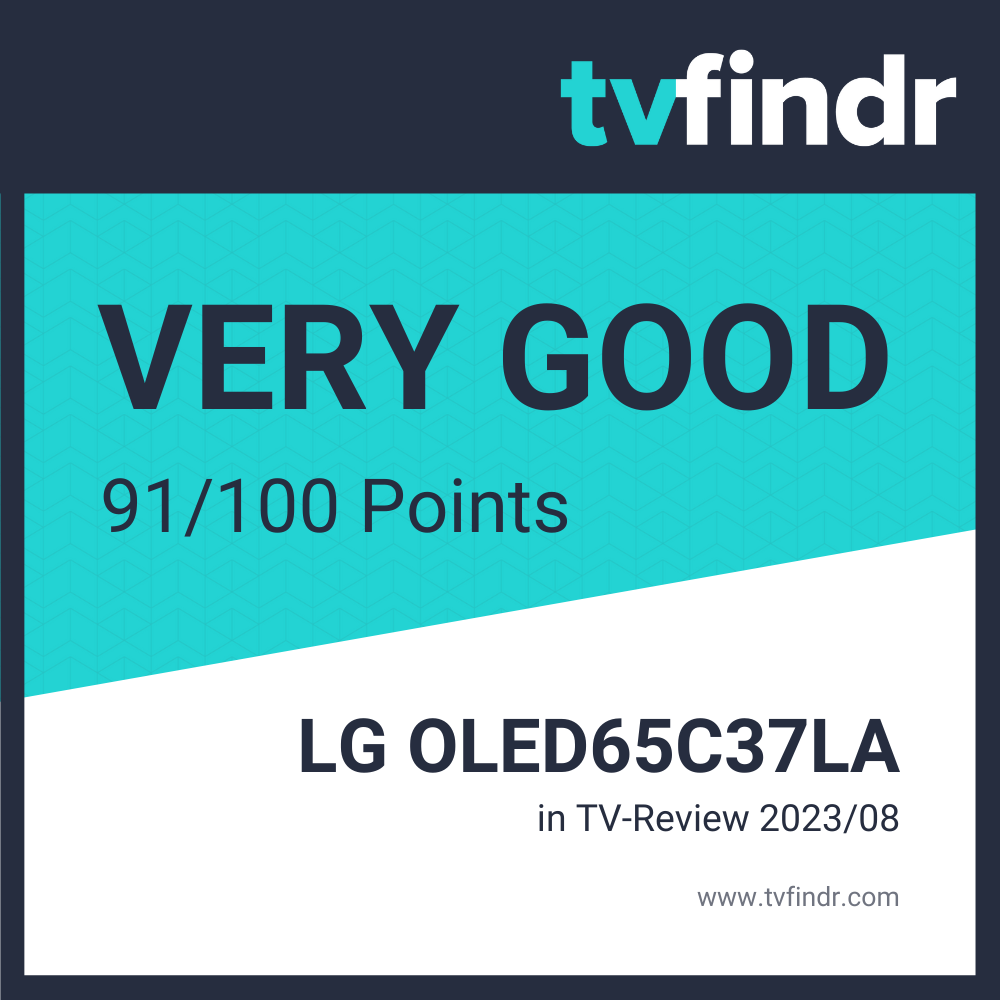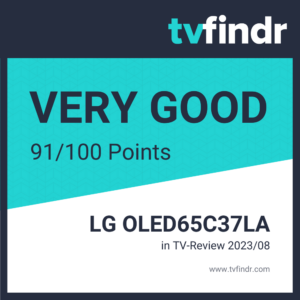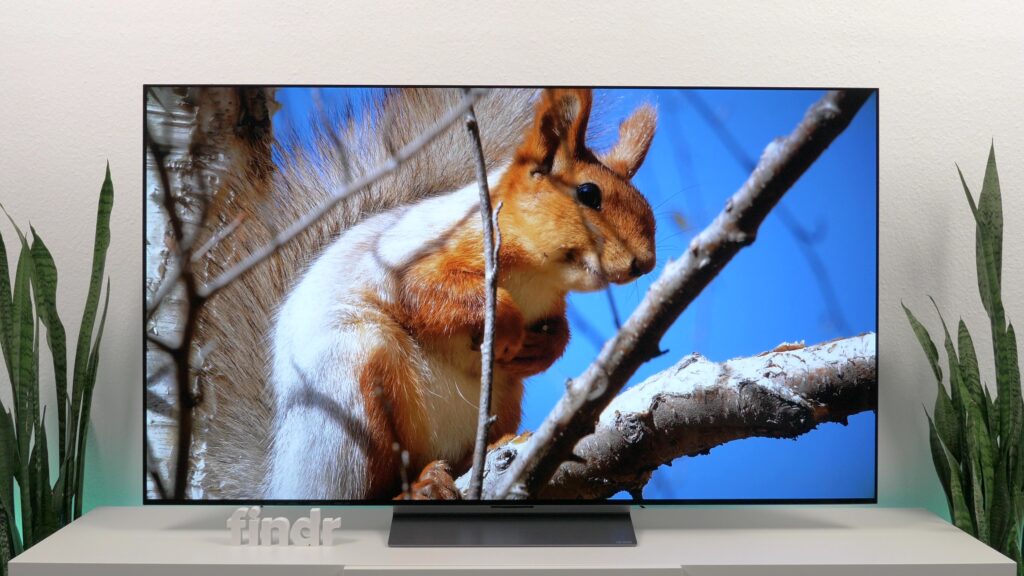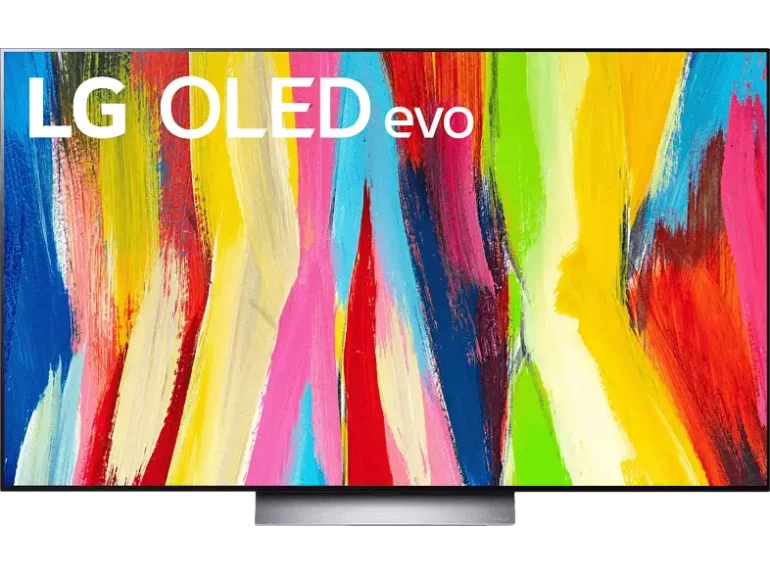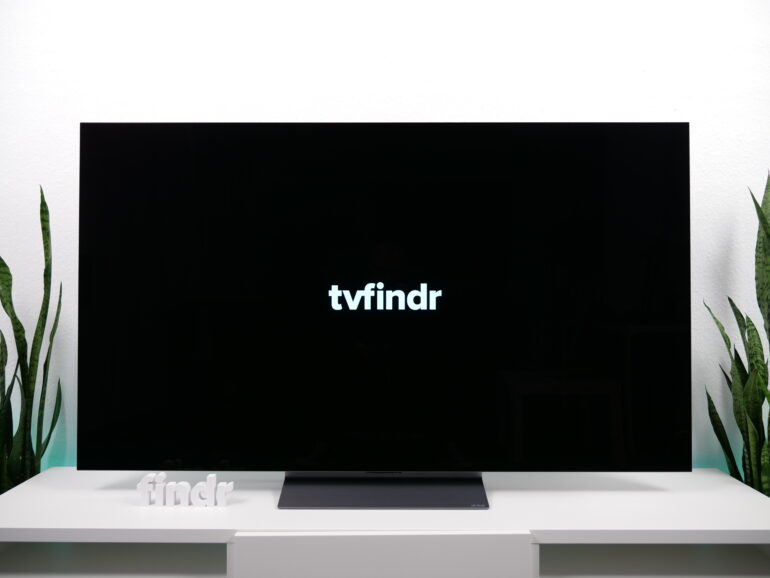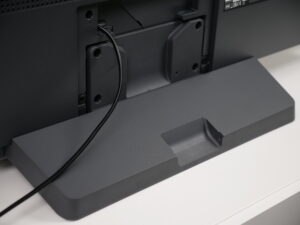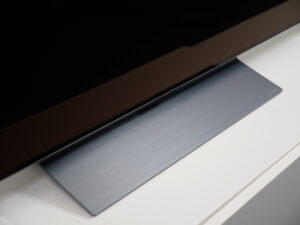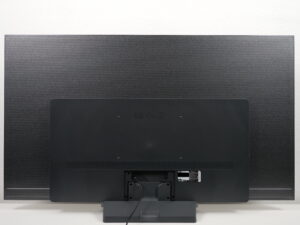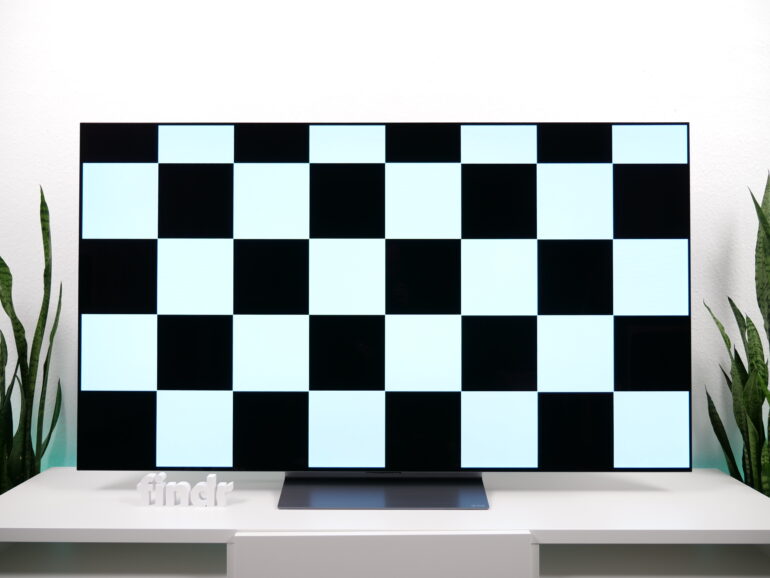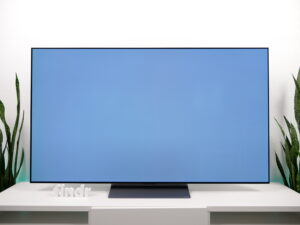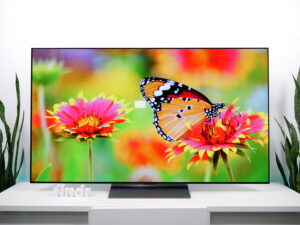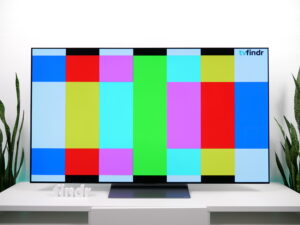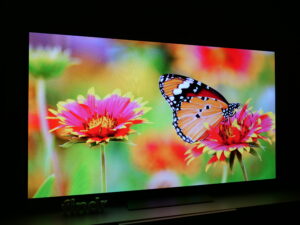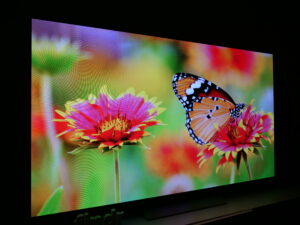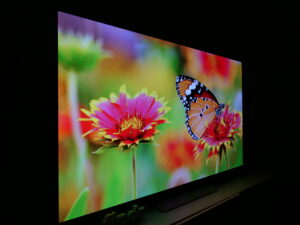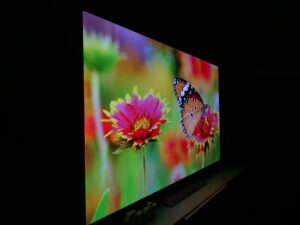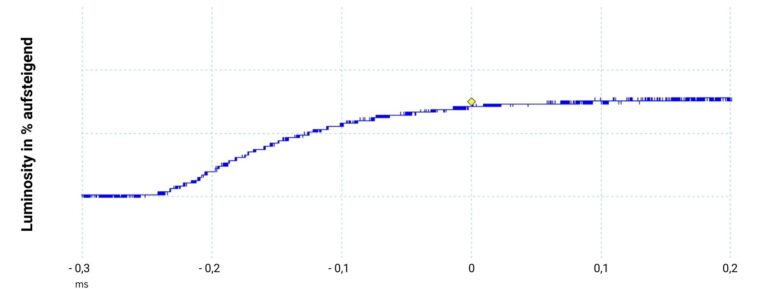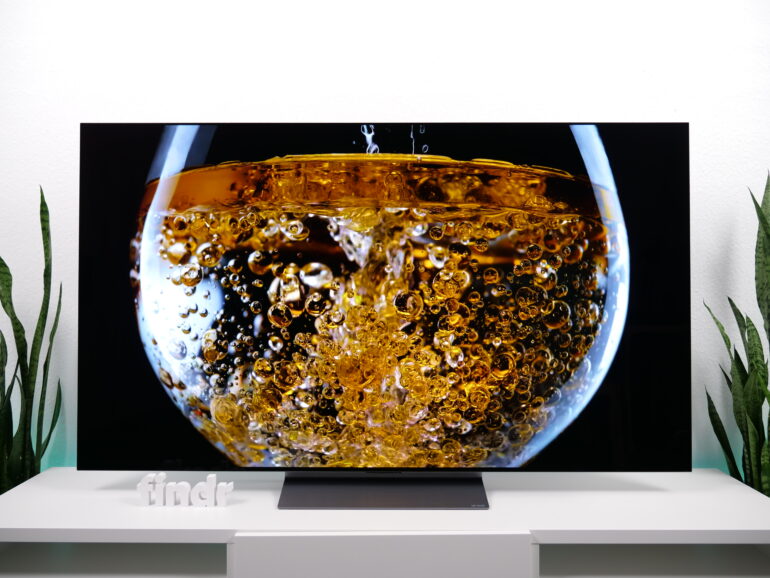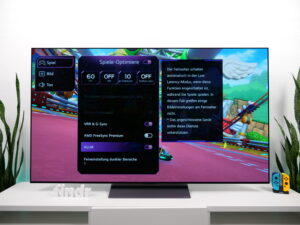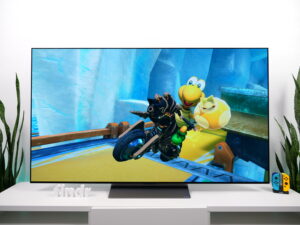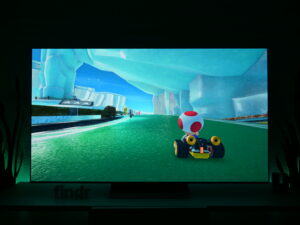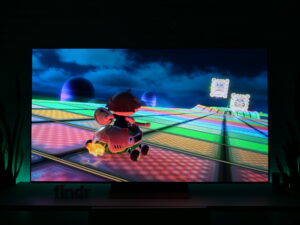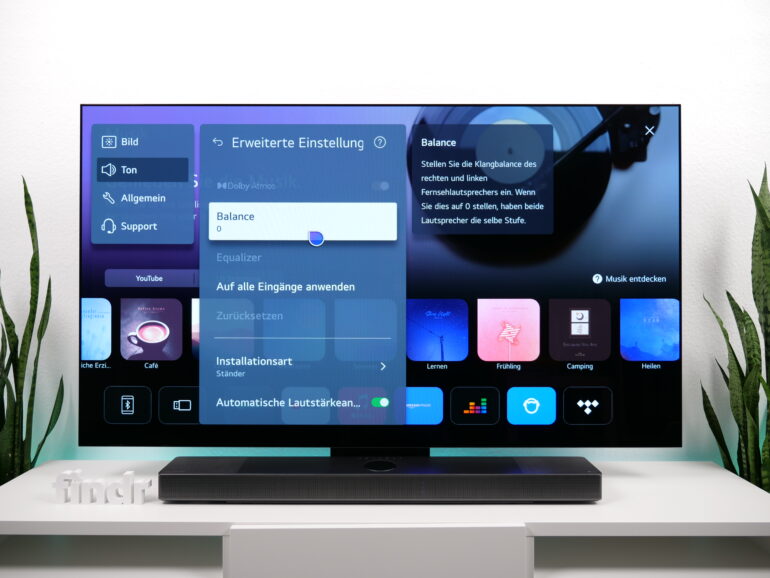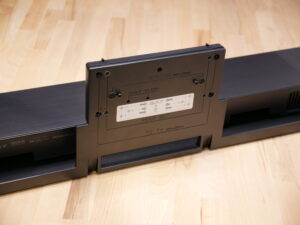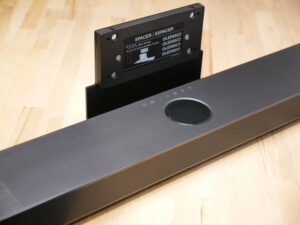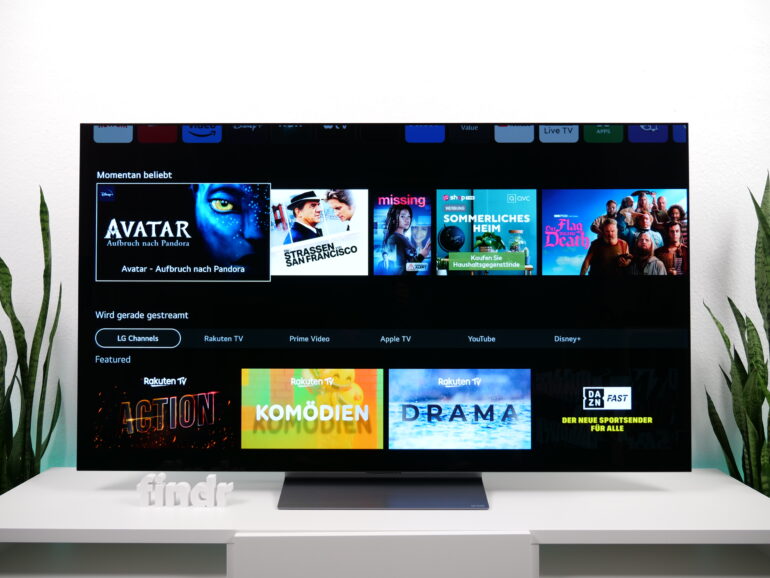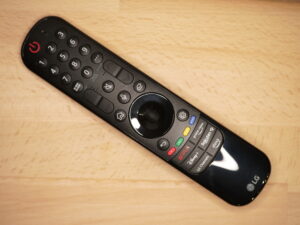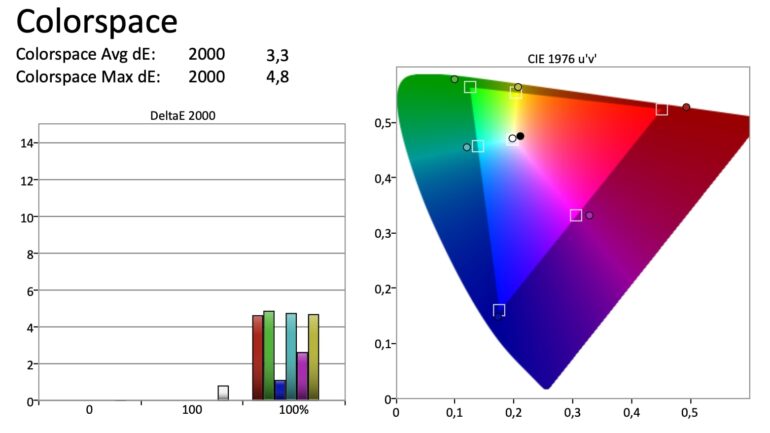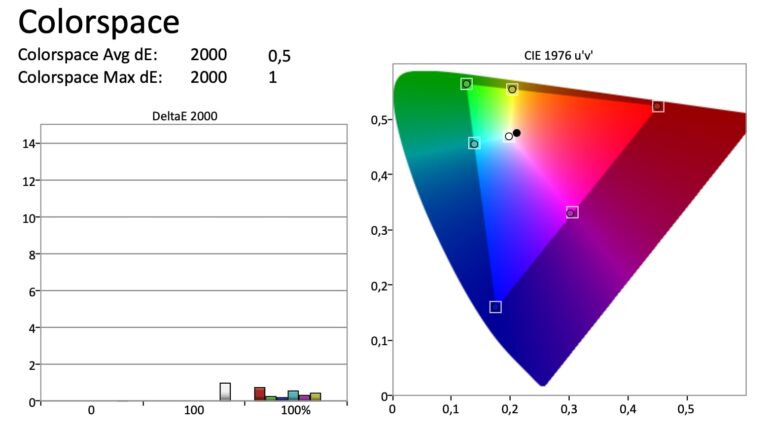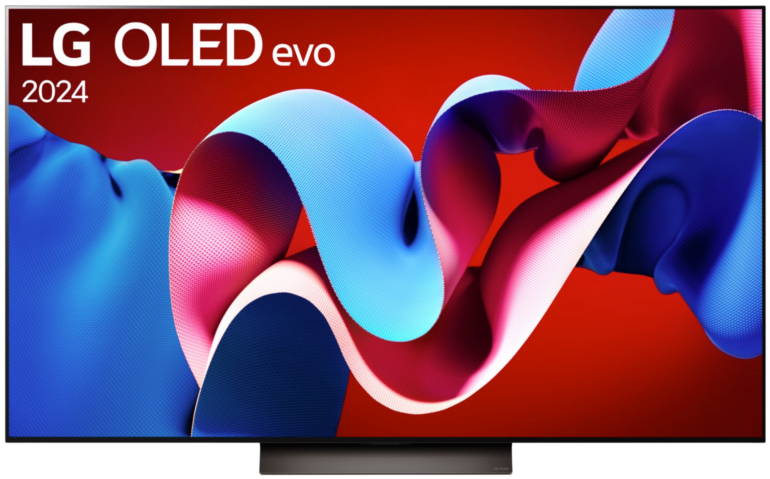LG OLED evo C3 Review & Rating

tvfindr Editorial
As a studied technology journalist Tobi likes to write regularly about the colorful world of TV sets & Co. Further interests: Music, cars, gaming, soccer
LG OLED evo C3 - Optimised successor without a big surprise
The LG OLED evo C3 is a really good choice for all those who have not yet decided to get an OLED TV, but are now slowly acquiring a taste for a self-emitting panel. If you already own the corresponding technology from previous years or even the direct successor, the purchase is only worthwhile to a limited extent. In our opinion, this TV has too little that is new to really justify a buy.
Regardless of this, the model basically does really well in terms of performance and features. In addition to a small brightness increase, especially the broad colour space coverage ensures fine colouration in scenes. The variety of HDRHigh Dynamic Range – image/video with more dynamic range (contrast range) formats is also quite good, with Dolby Vision IQDynamic HDR-format with a color depth of up to 12 Bits and Mastering of up to 10,000 Nits, which can adapt to the ambient brightness available once again. Gamers don’t have to make any compromises when it comes to LG. Almost everything that is currently demanded in the TV segment is available here.
LG provides new technology for the popular gaming series mainly in the form of the current Alpha 9 processor. To ensure sufficient sound pressure, however, we recommend thinking about an external solution, if you are not already well sorted in this area. One possibility is the combination with the new modular concept described in the test.
In addition to various Dolby formats, you then also have the option of passing on a DTSMulti-channel-sound-system (Surround Sound) competing with Dolby Digital:X signal. In terms of navigation, webOS 23 rounds things off, brings along a new picture assistant and is easy to operate in combination with the Magic Remote.
- High colour gamut
- Multiple HDR formats
- Extremely short response time
- Wide range of gaming features
- DTS as a passthrough option
- Quad HDMI 2.1 with 48 Gbps
- Native audio via eARC
- Various sizes available
- Noticeable dimming due to ABL
- Sound without pressure
- Panel without real upgrade
- Grey tones showing black banding
- No IMAX Support
Prices and Deals of LG OLED evo C3 *
| OLED evo C3 Series | Differences from the main variant OLED evo C37 | 42" | 48" | 55" | 65" | 77" | 83" |
|---|---|---|---|---|---|---|---|
| OLED evo C31 |
| OLED42C31LA | OLED48C31LA | OLED55C31LA | OLED65C31LA | OLED77C31LA | OLED83C31LA |
| OLED evo C32 |
| OLED42C32LA | OLED48C32LA | OLED55C32LA | OLED65C32LA | OLED77C32LA | |
| OLED evo C37 Variant tested here Main variant | OLED42C37LA | OLED48C37LA | OLED55C37LA 1,396.99 €* | OLED65C37LA 1,596.99 €* | OLED77C37LA | OLED83C37LA 3,496.99 €* | |
| OLED evo C38 |
| OLED42C38LA | OLED48C38LA | OLED55C38LA | OLED65C38LA | OLED77C38LA | |
| OLED evo C39LA |
| OLED48C39LA | OLED83C39LA | ||||
| OLED evo C39LC |
| OLED55C39LC | OLED65C39LC | OLED77C39LC |
Reasonable alternatives to the LG OLED evo C3
There are several alternative solutions in the C3 class that you should keep an eye on. First and foremost, the LG OLED evo C2 is the direct predecessor. Essentially, there are no major differences between these two TVs. If you can get by with a little less brightness, no DTS:X passthrough and the latest webOS version, the C2 is an interesting option.
Samsung’s S95B is cheaper and more powerful at the same time. The QD-OLED from 2022 is still one of the brightest models in the segment of self-luminous pixels and also offers you an extremely wide colour space. Candidate three is the Sony A80L with IMAX Enhanced compatibility. As a cinema fan, you can get even more out of the screen with this.
More affordable predecessor: LG OLED evo C27
Without Dolby Vision support: Samsung S95B
With IMAX support: Sony A80L
LG OLED evo C3: Not the fastest to set up
As soon as we picked up the box for the first time, we noticed that LG had designed its prestige model for the 2023 line-up one again with an eye for weight. As soon as the packaging material was removed from the casing, the comparatively low-weight TV was ready to be mounted on our table. The included stand consists of two elements.
A total of four screws holds the construction in place. Another four are needed to connect the substructure to the panelling. Although the procedure takes a moment, the screen then stands reasonably securely on the foundation. Quicker and more elegant are plug-in connections for which you don’t need any tools. However, you don’t get this comfort with the C3.
- Low weight
- High quality workmanship
- Stable base
- Pragmatic cable routing
- Modular solution for C3 and C2
- No height adjustment
- Foot not rotatable
Modular concept with deduction on the B grade
Since LG also supplied us with the matching DSC9S sound bar, we were allowed to get right back to it to replace the conventional foot directly with an alternative solution that comes with the sound bar. This specially adapted version is used to fix an external sound solution below the TV. You have the choice between the option for wall mounting and a version for standing the device upright.
In either case, depending on the screen diagonal, you will need one of the two adapter plates. In addition, the soundbar is firmly screwed to the stand at two points in the floor. Note: Connect all cables before you screw the housing on tightly. Otherwise, you may have problems accessing the latently hidden connections on the underside. Finally, a metal plate is attached to the back for additional support.
Although the solution is not particularly easy to install, it ultimately fulfils its purpose and cuts a good overall figure on our sideboard. Due to the generally higher weight, the LG OLED evo C3 is now clearly more stable than the factory version. Visually, the panel is neatly framed and offers the usual slim frame.
Design changes did practically not take place for the LG OLED evo C3
A closer look at the screen again reveals a noticeable pink colour cast. In general, the design has changed very little compared to the predecessor. The ports have remained in place, as has the fabric-like metal structure on the back.
Cables are routed away from the centre of the television. Two narrow clips ensure that all cables can be routed through the rear wall in an orderly manner and remain there. If necessary, you can conceal the plugs in the rear part with the connection cover, as usual. The drilling distance on the back is based on the VESA standard and is 300 x 200 millimetres for our 65-inch test model.
Despite few changes: Good performance of the LG OLED evo C3
The self-emitting pixels of the LG OLED evo C3 and the controller behind them stand out from the predecessor in a rather modest way when it comes to performance. Smaller image areas and fine highlights are brought onto the display with a little more brilliance.
LG has released a few more power reserves here. Typically, the automatic dimming visibly interferes in large, bright scenes that are shown on the display for a longer time.
- Remarkable colour gamut
- No halo effect
- Black at optimum level
- Colour precision with bright content
- Only a little brighter than the predecessor
- Near black banding on greys
However, you won’t find any real innovations such as the Micro Lens Array concept from the larger G3 or an integrated heat sink. Thus, the surface brightness also remains untouched at the already known level of the previous year. However, the new model offers slightly better values in SDR mode. To get your hands on the latest panel technology, you have to look at LG’s current flagship – apart from the competition.
Otherwise, you get the usual optimal OLED black and an overall great contrast with clear contours that don’t have any halo effect in low-light areas of the picture. While dark grey tones in our colour gradient show slight banding, our test device shines quite effortlessly with a quite precise uniformity in the reproduction of full screen grey colour.
Panel of the LG OLED evo C3 shows exceptional colour space coverage
The width of the colour gamut is remarkable and covers virtually the entire DCI P3 space. However, as the panel gets brighter, the C3 has more trouble displaying colours accurately. In general, the screen is not one of the most accurate ones in terms of colour representation, despite the enormous coverage.
Our stress test in terms of reflection resistance goes OK. The individual LEDs of our camera light still shine through relatively strongly even at maximum display brightness. Models like the S90C we tested can visibly contain the light rays more effectively at this point. We did not experience any noteworthy surprises with the viewing angle. As usual, the OLED evo panel meets our expectations in this respect.
This means that image content shows only slight colour shifts even from an oblique perspective. The majority of the luminosity is also largely retained and thus ensures a good result.
Well-working intermediate image calculation on the LG OLED evo C3
When dealing with fast and action-packed scenes, the LG OLED evo C3 shows its smooth side. Accordingly, the optional interpolation based on up to 120 frames basically works well. Movements appear noticeably smoother and can be recognised more clearly. Nevertheless, content with busy scenes sometimes does not remain completely without artefacts. As a consequence, you should expect the usual soap opera characteristics again.
- Pixels react almost without delay
- Well working interpolation
- Judder removal possible
- Not free of artefacts
- Soap Opera
Due to the extremely low response time – just 0.15 milliseconds in our test – you have to be prepared for visible jerkiness at low frame rates of the source material. This is typical for OLED TVs and therefore something we expected in advance. Especially in connection with smooth panning, you can see this conspicuousness well. There are several functions in the menu to help you deal with this problem.
With the help of the BFI function, you can reduce such stutters, but you have to reckon with a relatively strong loss of brightness and possibly intense image flickering. We therefore typically do not recommend activating this feature.
The LG OLED evo C3 eliminates image jerking in 24-frame-per-second films with the useful but rather misleading “Real Cinema” function. This phenomenon is also known as judder. Scenes are displayed at different lengths due to a 3:2 pulldown.
Extensive: That's the gaming equipment in the LG OLED evo C3
Gaming has been a priority at LG for many years. The pioneer in this area is still the C series. Models from this range regularly stand out with their broad equipment package and thus often offer you the best all-round carefree package. True to this principle, the LG OLED evo C3 also supports almost all components that are relevant for the inclined video gamer today and ensure a better gaming experience.
- 120 Hertz at 4K
- With G-Sync and FreeSync
- Game Optimizer
- Gaming via Cloud
- Dolby Vision Gaming
Although the South Korean manufacturer continues to rely on 120 hertz for the time being, this is still sufficient in view of the performance of current next-gen consoles. Platforms like the Xbox Series X|S or the PlayStation 5 are not capable of higher frame rates anyway. Even tech-savvy gamers who want to use the TV as a larger monitor in 42″ or 48″ with a powerful computer have enough quality leeway upwards in combination with the 4K resolution.
The same also applies in connection with the data rate. Since all four HDMI connections deliver the full bandwidth of the 2.1 version, a colour depth of 12 bits with full chroma sampling in UHD is possible. The range of functions not only includes FreeSync and HDMI Forum VRR, but also G-SyncVariable Refresh Rate for Nvidia graphics cards certification. This ensures an almost interference-free gaming experience from any VRR-capable source and counteracts screen tearing across the board.
Game optimizer with boost function
A shortened input lag can be achieved via the game optimizer in boost mode. At the same time, the familiar user interface compactly combines all additional central picture and sound functions. In addition, the current refresh rate and the status of selected additional settings are displayed.
In conjunction with the Gaming Hub, you can access various cloud gaming services as needed. These include GeForce NOW and Blacknut. You can easily connect a compatible controller via Bluetooth. Unfortunately, not all known providers are available. Therefore, you cannot select the xCloud service from Microsoft. However, in this case you have the option of using the service via the integrated browser. Finally, Xbox owners also benefit from Dolby Vision Gaming.
With the LG OLED evo C3, the sound adapts to the content
Depending on the content, you can comfortably tune the sound of the 2.2 sound system with 40 watts of power based on several presets. Only the automatic AI Pro function did not really appeal to us. The audio signal seems overdriven and sounds a bit muddy to our ears. Of course, we can’t exclude that this observation is specifically related to the reproduced content and doesn’t have to be generally valid. As with so many things, it is ultimately your own taste that counts.
- DTS via passthrough
- Modular option allowing upgrade
- Uncompressed sound via eARC
- Multiple Dolby formats
- Low bass
- No headphone jack
Soundbar with modular concept as an alternative
In general, however, the audio system of the LG OLED evo C3 does not offer us much depth. Anything else would actually have surprised us here. Flat-screen TVs simply have more than a little trouble reproducing the full frequencyHertz is the derived SI-unit of frequency with 1Hz=1/s – When talking about TVs this means how many different pictures a TV can display in one second. band cleanly and effectively. The construction method plays an essential role here.
As already mentioned, in this particular case – in addition to the actual test unit – we were sensibly provided with the matching DSC9S soundbar, including a modular solution in the form of a custom-made stand. At this point, it should be mentioned that we will not go into more detail about the sound bar and its specifications than is necessary for the review.
Of course, the additional hardware has no influence on the rating of the TV. What is decisive is mainly the option provided by LG for retrofitting and the software handling of it. We were able to connect to the soundbar via Bluetooth in no time at all.
The LG Sound Sync function synchronises the playback with that of the TV if desired. In addition to Dolby Atmos, DTS:X is now also available as a so-called passthrough variant. This means that although the C3 is not able to play the sound itself, it can pass the signal through to external audio sources.
An eARC port also provides sufficient bandwidth for the transmission of uncompressed audio. However, you will have to do without a classic headphone jack. Fortunately, if you decide to mount the unit on a wall, you do not need to make any major changes to the modular design. Only the additional end plate on the back must be unscrewed.
Navigate with Magic Remote and webOS 23 on the LG OLED evo C3
Even though LG has broken up the structure in one place or another in recent years, the settings menu of the webOS 23 user interface in particular is tidy and well sorted. In combination with the included Magic Remote, navigating through the structure of the operating system is even easier and usually quite helpful.
- Useful picture assistant
- AirPlay 2 and Homekit compatible
- Hands Free Voice Control
- QMS Support
Additional LG Channels and hands-free communication
A new addition is the personalised picture assistant. Based on several predefined images, you tell the algorithm of the LG OLED evo C3 your optical preferences. Based on this, the TV adjusts the picture settings accordingly. In this way, LG provides users who do not want to spend a lot of time configuring the device with a simple tool for optimising the display.
In addition to the typically large app selection and many streaming services, the free, but advertising-based LG Channels offer has been expanded to include additional channels. Among other things, the group has entered into a cooperation with DAZN for this purpose. FIFA+ is now also part of the channel selection.
Using the familiar Hands Free Voice Control, you can communicate with Alexa or the internal ThinQ AI without a remote control, for example to search for specific content. You can use the “LG Mood” function to activate certain predefined ambience settings and thus immerse the room in a different ambience.
HDR calibration
Already quite precise before calibration
Even in the run-up to calibration, the LG OLED evo C3 shows a relatively precise side. Especially with regard to the representation of the greyscales, the panel makes a thoroughly positive impression. An average error of 0.9 points and a maximum error score of 1.7 are absolutely within reason and require almost no additional adjustment. Nevertheless, there is some upward potential in this area. In the region of 50 to 95 per cent light intensity, the accuracy is not yet at the desired level.
The RGB colour balance also shows hardly any fluctuations worth mentioning and, apart from a slight deviation in the brighter tones, is consistently within the tolerance range. The situation is different, however, with the colour space. Here, our software hit several tones with deviations of just under five error points. Only blue was not quite as noticeable and was clearly below this level. The colour reproduction in particular still offers some room for correction.
More accurate than rarely after calibration
Afterwards, the already good initial result is all the more accurate. In plain language, this means hardly any inaccuracies in terms of brightness gradation on the evaluation sheet. Visually, the improvements are hardly noticeable on the EOTF curve. The aforementioned good colour balance could also be adjusted a little and now follows the tolerance range even more accurately. The remaining inconsistencies in the mixing ratio of blue, red and green have also disappeared.
The anomalies within the colour representation have shrunk to a minimum through the calibration and are just within a range of only 0.5 error points on average. On the one hand, our résumé shows that even with a high degree of accuracy, there is still room for optimisation. On the other hand, we are honestly talking about the last few percent of panel fine-tuning, for which the average consumer usually has to dig into his wallet.
LG OLED evo C3 Datasheet
OLED42C37LA technical specifications
Dimensions
| Screen diagonal | 42 Inch |
|---|---|
| Dimensions without stand (WxHxD) | 932 x 540 x 41 mm |
| Weight without stand | 9,8 kg |
| Dimensions with stand (WxHxD) | 932 x 577 x 170 mm |
| Weight with stand | 10,1 kg |
| Footprint (WxD) | 718 x 170 mm |
| VESA Norm | 300 x 200 mm |
Image properties
| Panel type | OLED evo Panel |
|---|---|
| Panel Manufacturer | LG Display |
| Colour depth | 10 Bit |
| FRC | |
| Resolution | 4K |
| Contrast ratio | infinitely :1 |
| Color space coverage | 74 % |
| REC 2020 | 34 % |
| Average brightness | 730 Nits |
| Maximum brightness | 830 Nits |
| Backlighting | OLED |
| Local dimming | OLED |
| Dimming Zones | OLED |
| Curved | |
| Improved viewing angle |
Motion Handling
| Response Time | < 1 ms |
|---|---|
| Input Lag | < 11 ms |
| Frequency | 120 Hz |
| VRR |
HDR
| HDR | |
|---|---|
| HDR10 | |
| HLG | |
| HDR10+ | N/A |
| Dolby Vision |
Energy
| Energy consumption standby (W) | 0,5 W |
|---|---|
| Energy consumption SDR | 52 W |
| Energy efficiency clas SDR | G |
| Energy consumption HDR | 84 W |
| Energy efficiency clas HDR | G |
Smart TV
| Operating system | webOS 23 |
|---|---|
| Bluetooth | |
| WLAN | |
| USB recording PVR | |
| Timeshift | |
| Picture-in-picture | |
| Tuner | Analog (NTSC/PAL/SECAM) DVB-T DVB-T2 DVB-C DVB-S DVB-S2 |
| Twin Tuner |
Audio
| Audio Channels | 2.0 |
|---|---|
| Power (W) | 20 W |
| Dolby Digital | |
| DTS | Ja |
| Dolby Atmos | |
| Integrated soundbar |
Connections
| HDMI 2.0 | |
|---|---|
| HDMI 2.1 | 4 |
| HDMI ARC | |
| USB 2.0 | 3 |
| USB 3.0 | |
| Ethernet RJ45 | 1 |
| 3.5mm jack | |
| Digital optical | 1 |
| Satellite | 2 |
| Antenna | 1 |
| Ci+ 1.4 | 1 |
OLED48C37LA technical specifications
Dimensions
| Screen diagonal | 48 Inch |
|---|---|
| Dimensions without stand (WxHxD) | 1071 x 618 x 47 mm |
| Weight without stand | 14,9 kg |
| Dimensions with stand (WxHxD) | 1071 x 675 x 230 mm |
| Weight with stand | 16,8 kg |
| Footprint (WxD) | 470 x 230 mm |
| VESA Norm | 300 x 200 mm |
Image properties
| Panel type | OLED evo Panel |
|---|---|
| Panel Manufacturer | LG Display |
| Colour depth | 10 Bit |
| FRC | |
| Resolution | 4K |
| Contrast ratio | infinitely :1 |
| Color space coverage | 74 % |
| REC 2020 | 34 % |
| Average brightness | 730 Nits |
| Maximum brightness | 830 Nits |
| Backlighting | OLED |
| Local dimming | OLED |
| Dimming Zones | OLED |
| Curved | |
| Improved viewing angle |
Motion Handling
| Response Time | < 1 ms |
|---|---|
| Input Lag | < 11 ms |
| Frequency | 120 Hz |
| VRR |
HDR
| HDR | |
|---|---|
| HDR10 | |
| HLG | |
| HDR10+ | N/A |
| Dolby Vision |
Energy
| Energy consumption standby (W) | 0,5 W |
|---|---|
| Energy consumption SDR | 52 W |
| Energy efficiency clas SDR | G |
| Energy consumption HDR | 84 W |
| Energy efficiency clas HDR | G |
Smart TV
| Operating system | webOS 23 |
|---|---|
| Bluetooth | |
| WLAN | |
| USB recording PVR | |
| Timeshift | |
| Picture-in-picture | |
| Tuner | Analog (NTSC/PAL/SECAM) DVB-T DVB-T2 DVB-C DVB-S DVB-S2 |
| Twin Tuner |
Audio
| Audio Channels | 2.2 |
|---|---|
| Power (W) | 40 W |
| Dolby Digital | |
| DTS | |
| Dolby Atmos | |
| Integrated soundbar |
Connections
| HDMI 2.0 | |
|---|---|
| HDMI 2.1 | 4 |
| HDMI ARC | |
| USB 2.0 | 3 |
| USB 3.0 | |
| Ethernet RJ45 | 1 |
| 3.5mm jack | |
| Digital optical | 1 |
| Satellite | 2 |
| Antenna | 1 |
| Ci+ 1.4 | 1 |
OLED55C37LA technical specifications
Dimensions
| Screen diagonal | 55 Inch |
|---|---|
| Dimensions without stand (WxHxD) | 1222 x 703 x 45 mm |
| Weight without stand | 14,1 kg |
| Dimensions with stand (WxHxD) | 1222 x 757 x 230 mm |
| Weight with stand | 16 kg |
| Footprint (WxD) | 470 x 230 mm |
| VESA Norm | 300 x 200 mm |
Image properties
| Panel type | OLED evo Panel |
|---|---|
| Panel Manufacturer | LG Display |
| Colour depth | 10 Bit |
| FRC | |
| Resolution | 4K |
| Contrast ratio | infinitely :1 |
| Color space coverage | 74 % |
| REC 2020 | 34 % |
| Average brightness | 730 Nits |
| Maximum brightness | 830 Nits |
| Backlighting | OLED |
| Local dimming | OLED |
| Dimming Zones | OLED |
| Curved | |
| Improved viewing angle |
Motion Handling
| Response Time | < 1 ms |
|---|---|
| Input Lag | < 11 ms |
| Frequency | 120 Hz |
| VRR |
HDR
| HDR | |
|---|---|
| HDR10 | |
| HLG | |
| HDR10+ | N/A |
| Dolby Vision |
Energy
| Energy consumption standby (W) | 0,5 W |
|---|---|
| Energy consumption SDR | 81 W |
| Energy efficiency clas SDR | G |
| Energy consumption HDR | 143 W |
| Energy efficiency clas HDR | G |
Smart TV
| Operating system | webOS 23 |
|---|---|
| Bluetooth | |
| WLAN | |
| USB recording PVR | |
| Timeshift | |
| Picture-in-picture | |
| Tuner | Analog (NTSC/PAL/SECAM) DVB-T DVB-T2 DVB-C DVB-S DVB-S2 |
| Twin Tuner |
Audio
| Audio Channels | 2.2 |
|---|---|
| Power (W) | 40 W |
| Dolby Digital | |
| DTS | |
| Dolby Atmos | |
| Integrated soundbar |
Connections
| HDMI 2.0 | |
|---|---|
| HDMI 2.1 | 4 |
| HDMI ARC | |
| USB 2.0 | 3 |
| USB 3.0 | |
| Ethernet RJ45 | 1 |
| 3.5mm jack | |
| Digital optical | 1 |
| Satellite | 2 |
| Antenna | 1 |
| Ci+ 1.4 | 1 |
OLED65C37LA technical specifications
Dimensions
| Screen diagonal | 65 Inch |
|---|---|
| Dimensions without stand (WxHxD) | 1441 x 826 x 45 mm |
| Weight without stand | 16,6 kg |
| Dimensions with stand (WxHxD) | 1441 x 880 x 230 mm |
| Weight with stand | 18,5 kg |
| Footprint (WxD) | 470 x 230 mm |
| VESA Norm | 300 x 200 mm |
Image properties
| Panel type | OLED evo Panel |
|---|---|
| Panel Manufacturer | LG Display |
| Colour depth | 10 Bit |
| FRC | |
| Resolution | 4K |
| Contrast ratio | infinitely :1 |
| Color space coverage | 74 % |
| REC 2020 | 34 % |
| Average brightness | 730 Nits |
| Maximum brightness | 830 Nits |
| Backlighting | OLED |
| Local dimming | OLED |
| Dimming Zones | OLED |
| Curved | |
| Improved viewing angle |
Motion Handling
| Response Time | < 1 ms |
|---|---|
| Input Lag | < 11 ms |
| Frequency | 120 Hz |
| VRR |
HDR
| HDR | |
|---|---|
| HDR10 | |
| HLG | |
| HDR10+ | N/A |
| Dolby Vision |
Energy
| Energy consumption standby (W) | 0,5 W |
|---|---|
| Energy consumption SDR | 97 W |
| Energy efficiency clas SDR | F |
| Energy consumption HDR | 175 W |
| Energy efficiency clas HDR | G |
Smart TV
| Operating system | webOS 23 |
|---|---|
| Bluetooth | |
| WLAN | |
| USB recording PVR | |
| Timeshift | |
| Picture-in-picture | |
| Tuner | Analog (NTSC/PAL/SECAM) DVB-T DVB-T2 DVB-C DVB-S DVB-S2 |
| Twin Tuner |
Audio
| Audio Channels | 2.2 |
|---|---|
| Power (W) | 40 W |
| Dolby Digital | |
| DTS | |
| Dolby Atmos | |
| Integrated soundbar |
Connections
| HDMI 2.0 | |
|---|---|
| HDMI 2.1 | 4 |
| HDMI ARC | |
| USB 2.0 | 3 |
| USB 3.0 | |
| Ethernet RJ45 | 1 |
| 3.5mm jack | |
| Digital optical | 1 |
| Satellite | 2 |
| Antenna | 1 |
| Ci+ 1.4 | 1 |
OLED77C37LA technical specifications
Dimensions
| Screen diagonal | 77 Inch |
|---|---|
| Dimensions without stand (WxHxD) | 1711 x 982 x 47 mm |
| Weight without stand | 23,5 kg |
| Dimensions with stand (WxHxD) | 1711 x 1035 x 267 mm |
| Weight with stand | 27,1 kg |
| Footprint (WxD) | 520 x 267 mm |
| VESA Norm | 300 x 200 mm |
Image properties
| Panel type | OLED evo Panel |
|---|---|
| Panel Manufacturer | LG Display |
| Colour depth | 10 Bit |
| FRC | |
| Resolution | 4K |
| Contrast ratio | infinitely :1 |
| Color space coverage | 74 % |
| REC 2020 | 34 % |
| Average brightness | 730 Nits |
| Maximum brightness | 830 Nits |
| Backlighting | OLED |
| Local dimming | OLED |
| Dimming Zones | OLED |
| Curved | |
| Improved viewing angle |
Motion Handling
| Response Time | < 1 ms |
|---|---|
| Input Lag | < 11 ms |
| Frequency | 120 Hz |
| VRR |
HDR
| HDR | |
|---|---|
| HDR10 | |
| HLG | |
| HDR10+ | N/A |
| Dolby Vision |
Energy
| Energy consumption standby (W) | 0,5 W |
|---|---|
| Energy consumption SDR | 126 W |
| Energy efficiency clas SDR | F |
| Energy consumption HDR | 239 W |
| Energy efficiency clas HDR | G |
Smart TV
| Operating system | webOS 23 |
|---|---|
| Bluetooth | |
| WLAN | |
| USB recording PVR | |
| Timeshift | |
| Picture-in-picture | |
| Tuner | Analog (NTSC/PAL/SECAM) DVB-T DVB-T2 DVB-C DVB-S DVB-S2 |
| Twin Tuner |
Audio
| Audio Channels | 2.2 |
|---|---|
| Power (W) | 40 W |
| Dolby Digital | |
| DTS | |
| Dolby Atmos | |
| Integrated soundbar |
Connections
| HDMI 2.0 | |
|---|---|
| HDMI 2.1 | 4 |
| HDMI ARC | |
| USB 2.0 | 3 |
| USB 3.0 | |
| Ethernet RJ45 | 1 |
| 3.5mm jack | |
| Digital optical | 1 |
| Satellite | 2 |
| Antenna | 1 |
| Ci+ 1.4 | 1 |
OLED83C37LA technical specifications
Dimensions
| Screen diagonal | 83 Inch |
|---|---|
| Dimensions without stand (WxHxD) | 1851 x 1062 x 55 mm |
| Weight without stand | 32,3 kg |
| Dimensions with stand (WxHxD) | 1851 x 1092 x 279 mm |
| Weight with stand | 41,6 kg |
| Footprint (WxD) | 1199 x 279 mm |
| VESA Norm | 400 x 400 mm |
Image properties
| Panel type | OLED evo Panel |
|---|---|
| Panel Manufacturer | LG Display |
| Colour depth | 10 Bit |
| FRC | |
| Resolution | 4K |
| Contrast ratio | infinitely :1 |
| Color space coverage | 74 % |
| REC 2020 | 34 % |
| Average brightness | 730 Nits |
| Maximum brightness | 830 Nits |
| Backlighting | OLED |
| Local dimming | OLED |
| Dimming Zones | OLED |
| Curved | |
| Improved viewing angle |
Motion Handling
| Response Time | < 1 ms |
|---|---|
| Input Lag | < 11 ms |
| Frequency | 120 Hz |
| VRR |
HDR
| HDR | |
|---|---|
| HDR10 | |
| HLG | |
| HDR10+ | N/A |
| Dolby Vision |
Energy
| Energy consumption standby (W) | 0,5 W |
|---|---|
| Energy consumption SDR | 150 W |
| Energy efficiency clas SDR | F |
| Energy consumption HDR | 282 W |
| Energy efficiency clas HDR | G |
Smart TV
| Operating system | webOS 23 |
|---|---|
| Bluetooth | |
| WLAN | |
| USB recording PVR | |
| Timeshift | |
| Picture-in-picture | |
| Tuner | Analog (NTSC/PAL/SECAM) DVB-T DVB-T2 DVB-C DVB-S DVB-S2 |
| Twin Tuner |
Audio
| Audio Channels | 2.2 |
|---|---|
| Power (W) | 40 W |
| Dolby Digital | |
| DTS | |
| Dolby Atmos | |
| Integrated soundbar |
Connections
| HDMI 2.0 | |
|---|---|
| HDMI 2.1 | 4 |
| HDMI ARC | |
| USB 2.0 | 3 |
| USB 3.0 | |
| Ethernet RJ45 | 1 |
| 3.5mm jack | |
| Digital optical | 1 |
| Satellite | 2 |
| Antenna | 1 |
| Ci+ 1.4 | 1 |
Frequently asked questions on the LG OLED evo C3
What are the disadvantages of OLED panels?
What is an OLED.EX panel?
Which LG OLED is the best?
Based on sheer performance, the LG OLED evo G3 with its MLA panel comes out on top. The price-performance winner is currently still the LG OLED CS9.
What is so special about the LG Magic Remote?
Unique to the LG remote control is the controllable mouse pointer. As soon as you move the input device back and forth a little, a cursor appears that allows direct motion control without using the directional keys.
LG OLED evo C3 Connections
The OLED65C37LA has 4 HDMI 2.1 inputs, an HDMI eARC, 3 USB 2.0 ports, a digital optical TOSLINK output and a Twin Tuner. and just a Single Tuner.
LG OLED evo C3 Dimensions
The LG OLED evo C3 is dimensioned without stand as follows (WxHxD):
- 42 Inch: 932 x 540 x 41 mm
- 48 Inch: 1071 x 618 x 47 mm
- 55 Inch: 1222 x 703 x 45 mm
- 65 Inch: 1441 x 826 x 45 mm
- 77 Inch: 1711 x 982 x 47 mm
- 83 Inch: 1851 x 1062 x 55 mm
LG OLED evo C3 Wall Mounting
The LG OLED evo C3 is compatible with the following wall mounts:
- 42 Inch:
300 x 200 mmFlat Pivotable
- 48 Inch:
300 x 200 mmFlat Pivotable
- 55 Inch:
300 x 200 mmFlat Pivotable
- 65 Inch:
300 x 200 mmFlat Pivotable
- 77 Inch:
300 x 200 mmFlat Pivotable
- 83 Inch:
400 x 400 mmFlat Pivotable
